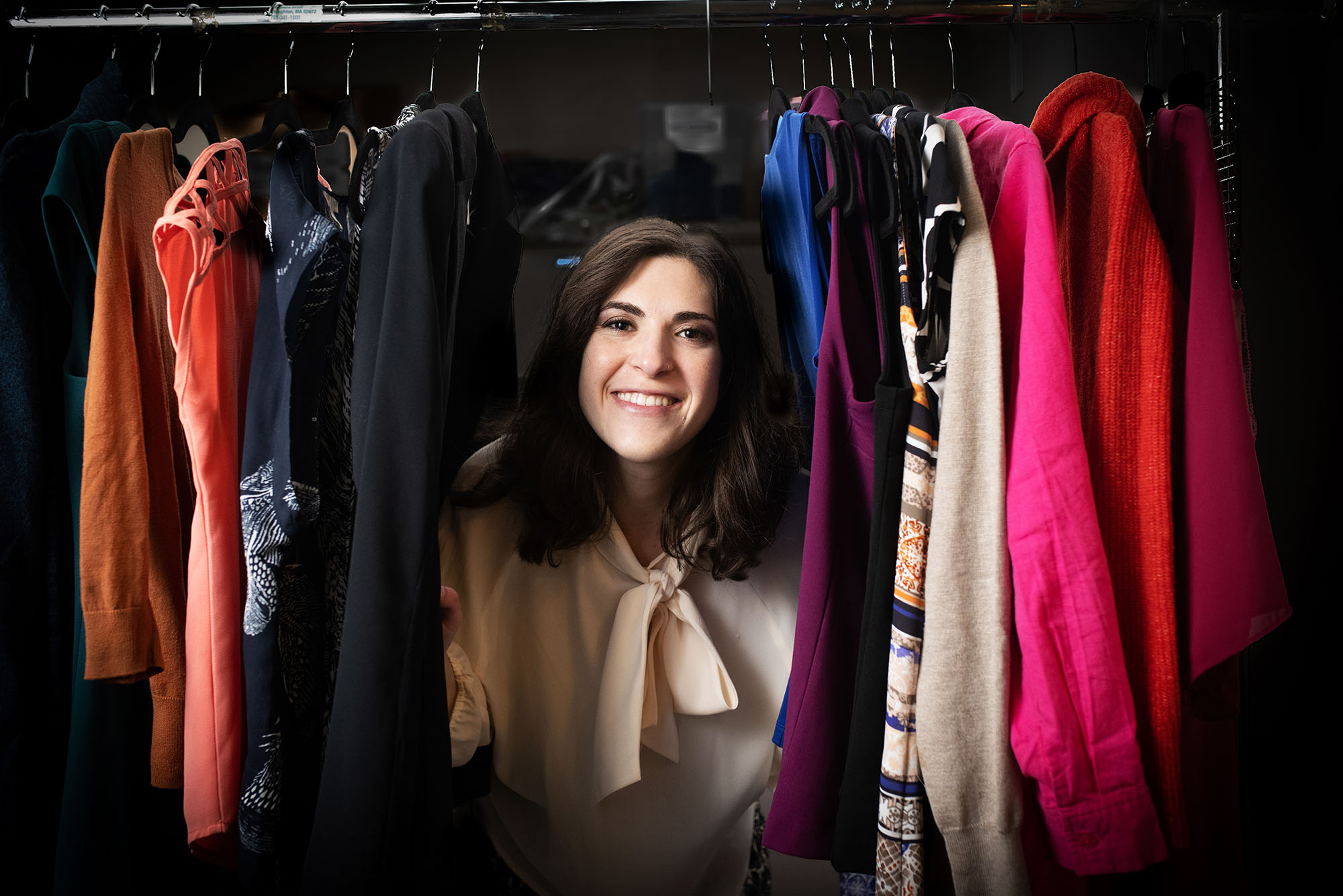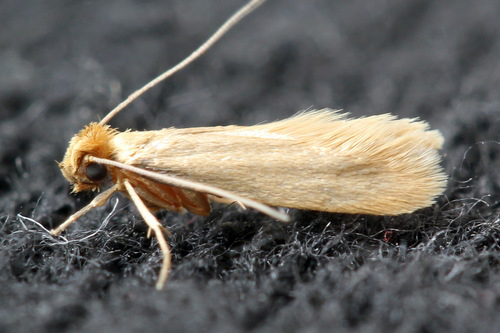Elevating the Clothes-Eating Moth from Pest to Evolutionary Marvel
Wondering how to rid your closet of the webbing clothes moth? Maybe it’s time to learn to live with them—they can boost ecosystems and could help eat heavy metals

Isabel Novick (GRS’27’27), a BU biology PhD student, studies Tineola bisselliella—the moths that live in your closet and feast on your clothing.
Elevating the Clothes-Eating Moth from Pest to Evolutionary Marvel
Wondering how to rid your closet of the webbing clothes moth? Maybe it’s time to learn to live with them—they can boost ecosystems and could help eat heavy metals
There’s something for everyone in the animal kingdom. Some people are drawn to cuddly home companions, some to powerful jungle predators, and others to fascinating undersea life. Isabel Novick likes clothes-eating moths, the little pests that feast on cashmere cardigans and polyester sheets with equal zeal.
Although one paper estimates the annual damage done by these tiny dust-brown flyers—typically no bigger than a grain of rice—at $1 billion in the United States alone, Novick (GRS’27,’27) says they could one day help us solve some of our most frustrating problems, instead of being one of them. The moths have evolved to digest not just fibers, she says, but also keratin, horsehair plaster, and even heavy metals like lead and mercury. A Boston University biology PhD student, Novick intends to find out how they do it—and if we can put their eating skills to good use.
In partnership with fellow graduate student Jasmine Alqassar (CGS’21, CAS’24, GRS’24), Novick spends her days in professor Sean P. Mullen’s evolutionary genomics lab in the BU Graduate School of Arts & Sciences, where they are engaged in cracking the particular evolutionary puzzle posed by Tineola bisselliella, or the webbing clothes moth. The moths are basal in their phylogenetic tree, meaning they’re an older evolutionary group from which a newer and greater variety of species later branched from.
The research is composed of three parts: In the first, Novick and her colleagues are annotating the Tineola bisselliella genome in the hopes of more accurately placing the webbing clothes moth within the Tineidae—or fungus moth—family tree. Second, Novick, Alqassar, and Mullen will perform a microbiome study with the goal of determining how the species is able to perform its signature move: digesting keratin and clothing fiber. Finally, Novick is contacting researchers around the world and asking them for samples of the webbing clothes moths they find to see whether the moths in American closets are genomically similar to those found in closets in Canada, Mexico, Chile, Nigeria, Australia, France, South Korea, and the State of Palestine.
While the idea of venerating this common parasite would cause most people to scratch their heads, Novick has no doubts about the importance of her research. “They have these cool behaviors and abilities that are rare, and that might actually be useful for us somehow,” she says. “You have to love the Earth, love all its organisms—they are all helpful to us in some way.”
The Brink spoke with Novick—who recently penned a defense of the moths for Entomology Today—about what inspired her research, where she hopes it will go, and why even a tiny, troublemaking moth deserves its moment in the spotlight.
Q&A
with Isabel Novick
The Brink: What made you decide to devote your PhD research to webbing clothes moths?
Novick: Before I started working here, I worked at the Museum of Science, Boston for two years. One of the main issues that I dealt with there was these clothes moths eating the taxidermy. We were just trying to protect all these artifacts that kept getting eaten. When I started here, I decided to work more on these clothes moths, because most of the research that’s been done into them is because they’re a pest, like how to get rid of them. There isn’t a lot of stuff about their evolutionary origins. They can metabolize keratin, synthetic fabric, and they can chew through plastic, and they can digest heavy metals like lead and mercury and arsenic; they can create their own water, which is crazy. They’re just little tanks and super hard to get rid of.
The Brink: Did you have a sense, when you were at the science museum, what you were dealing with?
Novick: I kind of knew. We had just been doing research to try and figure out the best control methods, because we didn’t want to use a lot of heavy chemicals in a public-facing environment, and these were precious artifacts that we were trying to protect. In looking into it, there wasn’t a lot of information about their evolutionary origins, or why they eat keratin, or are the moths we deal with in Massachusetts the same species as the species in Europe? It was so interesting to me that I wanted to know more about them, the way that they’ve evolved to be able to tolerate so much of our eradication measures, like freezing and heating. They’re just so strong. I admire their persistence and determination, because [it’s] a feat of evolution that they’ve been able to pass over all these hurdles that we can set forth for them.
The Brink: Are you looking at more of the why of their evolution, or the how?
Novick: It’s a little bit of both. We’re looking at how diet strategy has allowed them to colonize the indoor space. We’re thinking that having a keratin-based diet is going to correspond with multiple independent evolutions toward synanthropy, which is living alongside and benefiting from humans, like cockroaches and pigeons. We think that there’s going to be these repeated evolutionary origins of eating keratin that has facilitated living inside.
The Brink: How common or uncommon are their eating habits?
Novick: It’s pretty uncommon, especially among lepidopterans—butterflies and moths. In general, most caterpillars eat plants, flowers, and leaves, like the Very Hungry Caterpillar. Webbing clothes moths don’t really do that. They’re one of the older moth groups, and we think that maybe this could have been one of the original dietary strategies for moths and butterflies, but we don’t really know yet.
The Brink: The fact that they eat keratin—does that mean they’re not eating your clothes, but actually, they’re eating you?
Novick: That’s a great question. I would say having your presence on the clothes makes them way more attractive. They would prefer sweaty clothes to clean clothes. The only nutrient that they really need is vitamin B and that comes in your sweat or in your urine. If you pee your pants or something, that’d be delicious to moths, but they eat the fabric too. They really like wool, but they can eat mixed materials, too, which is pretty wild.

The Brink: What defenses can the clothes-wearer take, if any?
They’re super abundant in Boston. I feel like everyone I’ve talked to has clothes moths in their house. I would say the greenest method is preventative conservation of your clothes, like keeping your woolens and all of your sweaters in a tight, sealed container. That’s what I have to do, because they’re in my house too.
The Brink: On purpose, or by accident?
Right? When I moved in, I was like, “Oh no, I can never escape my work.” I actually took some from my house and I brought them to the lab, and now I have a breeding population that came from my house.
The Brink: You mention how moths have adapted to our habits, but how have we adapted to theirs?
If there are a lot of them in your house, it definitely makes you live your life in a different way. You might have to call pest control and get them to fumigate your whole house, because they can live in the walls. If you live in an old house, they can eat horsehair plaster, so sometimes you need to do a full clean out with chemicals. Storing your clothes in containers is not how people would probably prefer to store clothes.
The Brink: Is there any human benefit to the moths’ clothes-eating habits?
As far as I know, there’s no benefit to humans, really. I hesitate to use the word parasite, but I guess they’re not really commensal with us. One of the exciting things about doing this research, annotating the genome, is that maybe there’s something in there that’s really novel and unique and could somehow translate to human life. I would love someone else to get into this, because I don’t have time during my PhD, but in terms of sustainability, clothing waste is a big issue. I think it would be a really cool idea to have an organism that could break down a bunch of clothing, especially synthetics, which are harder to break down. It doesn’t seem like the most efficient way to do it would be to set a bunch of moths on a piece of clothing, but it would be cool if we found a bacterium that releases an enzyme that can break it down. And, if you could culture that independently from the moth, then you could just have this bacteria that can break down clothing and maybe reduce clothing waste. There are really interesting applications that maybe we haven’t thought of, because we’ve thought of them as a pest species for so long.
The Brink: Why do moths deserve the same—or better—reputation as butterflies?
I’ve been waiting for this question for my whole life. In general, moths provide the same ecosystem services as butterflies. They’re just like nighttime butterflies, basically, but they still pollinate. They’re still a food source for other organisms like birds and other insects, and they still provide value to the ecosystem. There are a lot of diversity of functions; in this family, there’s one whose larvae eat tortoise shells. How do they do it? We don’t know. Some eat wine corks. There’s some in a different family that lives in Hawaii that evolved to live underwater. They really capitalize on some crazy niches in ways that have gone overlooked, because they don’t look like butterflies. They’re not as beautiful, but I root for the underdog.
This interview was edited for clarity and brevity.


Comments & Discussion
Boston University moderates comments to facilitate an informed, substantive, civil conversation. Abusive, profane, self-promotional, misleading, incoherent or off-topic comments will be rejected. Moderators are staffed during regular business hours (EST) and can only accept comments written in English. Statistics or facts must include a citation or a link to the citation.